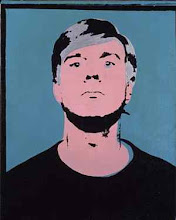The interior spaces are beautiful - the building is a sculpture in its own right; as an exhibition space it sort of works but is undeniably problematic.
Currently on show are 2 exhibitions of contemporary work: Storylines, a selection from the museum's collection organised around the idea of storytelling, and a retrospective survey of Doris Salcedo. Both exhibitions were very interesting but, in my view, Salcedo knocks the socks off everything else. Additionally there is a display of Impressionist, Post-Impressionist and early C20 work from the Thannhauser Collection.
Doris Salcedo's work is rooted in her response to the traumas and violence of political oppression particularly in relation to her native Columbia. However, what makes her work so powerful and effective is that its physical form universalises its meanings - that is, you don't need to know anything about Columbian politics to be touched by the poetic images and metaphors of a suffocating loss of liberty.
 |
| Doris Salcedo, installation view |
 |
| Doris Salcedo, Atrabiliaros, 1996 (detail) |
 |
| Doris Salcedo, Disremembered |
 |
| Doris Salcedo, Plegaria Muda, 2008-10 (detail) |
 |
| Shannon Ebner, Instrumentals, 2013 |
 |
|
Iván Navarro, Homeless Lamp, the Juice Sucker, 2004–05
|
 |
|
Gabriel Orozco, Astroturf Constellation, 2012
|
 |
|
Katie Paterson, Light bulb to Simulate Moonlight, 2008
|
 |
|
Natascha Sadr Haghighian, I can't work like this, 2007
|
 |
|
Paul Cézanne, Still Life: Flask, Glass, and Jug, c1877
|
 |
|
Édouard
Manet, Before the Mirror, 1876
|
 |
|
Pablo Picasso, Woman Ironing, Paris,
1904
|





No comments:
Post a Comment